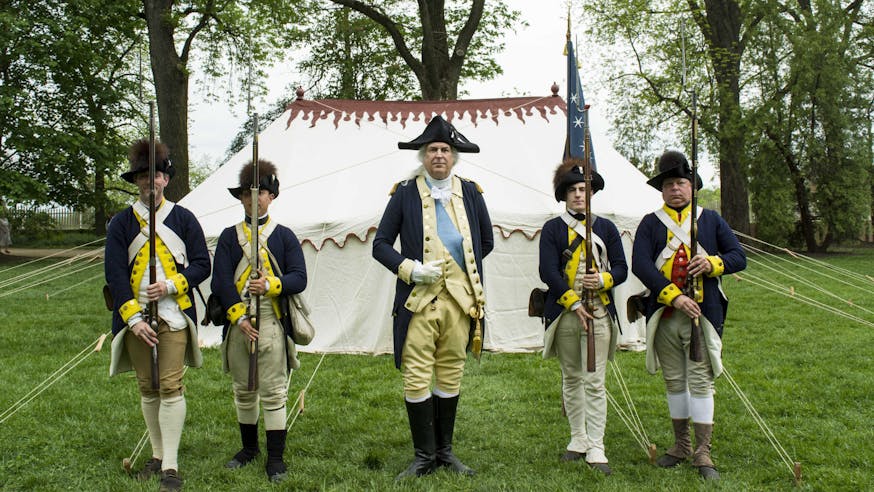Frequently Asked Questions: Washington's War Tent
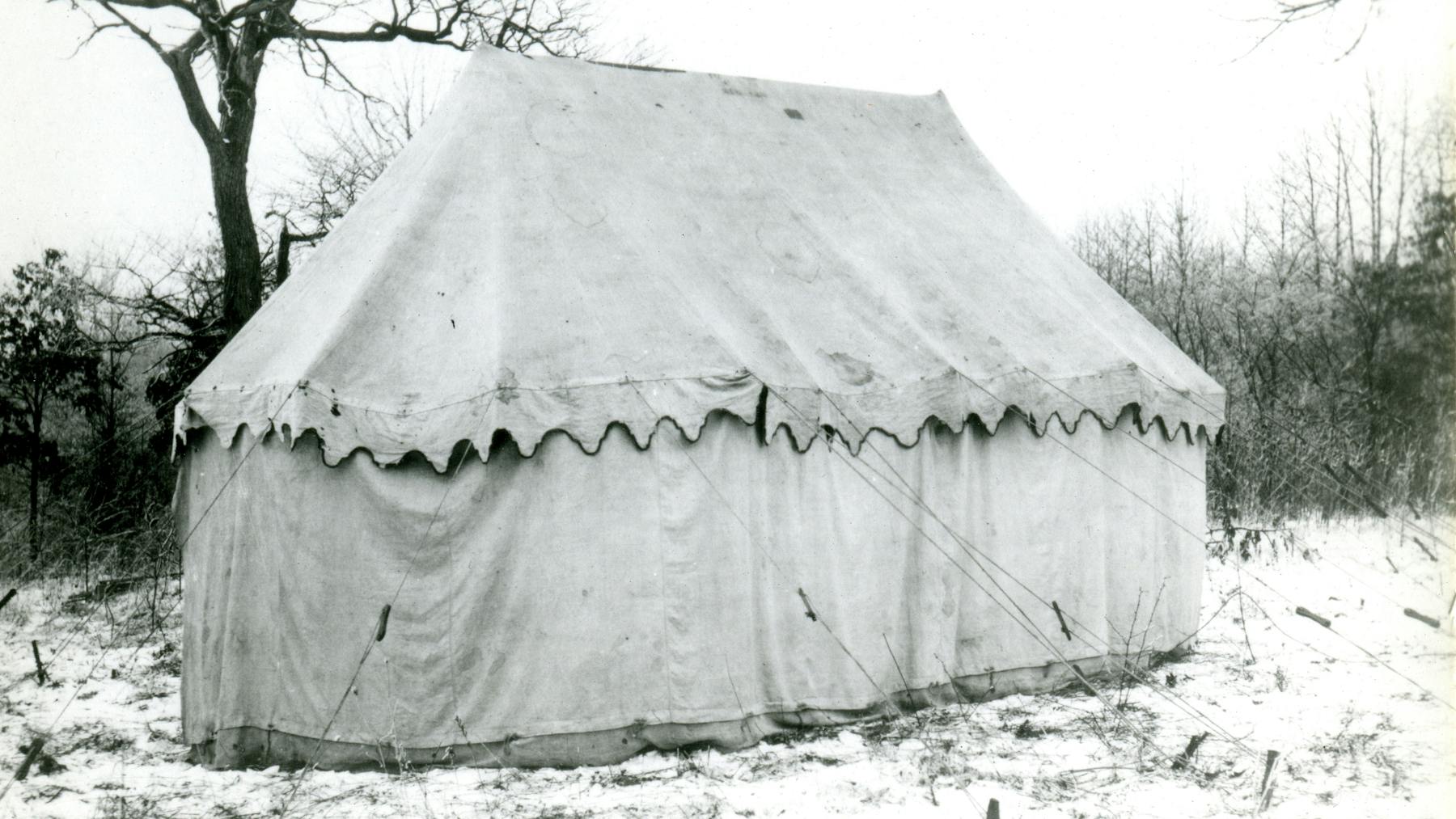
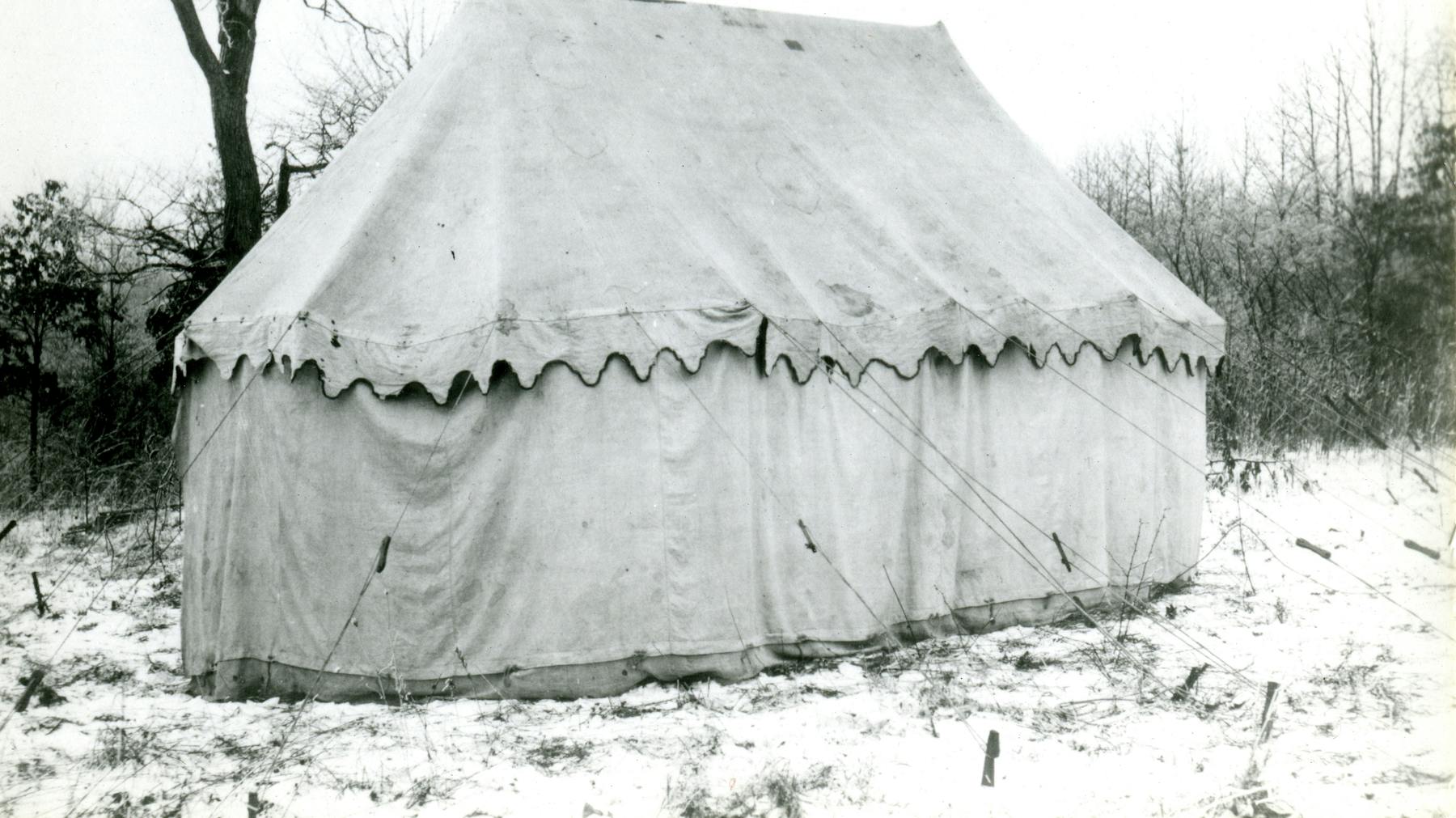
- First Oval Office Project Links FOOP Home Historical Timeline Real and Replica Programs and Outreach
-
Washington’s War Tent, his sleeping marquee that is on display at the Museum of the American Revolution, is full of mysteries. We solved some of them by making a hand-stitched replica that we could use as a “stunt double.” We can’t take the original tent out and set it up in the rain. The First Oval Office Project is an example of experimental archaeology. By creating replicas of historical objects like George Washington’s tent, we can learn new things about how and why people in the past made and used these things. Here are a few frequently asked questions you might have about Washington’s tent that the First Oval Office Project helped the Museum answer.
Frequently Asked Questions
Didn’t I see this tent, or another Washington tent, somewhere else?
You may have! The sleeping and office tent on display at the Museum of the American Revolution was previously on display at the Museum’s predecessor organization, the Valley Forge Historical Society at the Washington Memorial Chapel in Valley Forge, Pennsylvania. It was also on loan for a time to the National Park Service’s Valley Forge National Historical Park. You may also have seen Washington’s larger dining marquee tent on display at the Smithsonian’s National Museum of American History, but that tent is no longer on display. The National Park Service exhibits the inner office chamber associated with Washington’s sleeping and office tent at the Yorktown Visitor Center at Yorktown Battlefield in Virginia. Small pieces of Washington’s tents, cut off as souvenirs in the 1800s, are in the collection of many museums and historic sites
How big is George Washington’s tent?
Washington’s sleeping and office tent is an oval measuring 14 feet by 23 feet (or about 300 square feet). Its rope guylines fan out around the tent creating a footprint that measures about 45 feet by 36 feet. The tent is 12 feet tall at its highest points.
How many rooms are in Washington’s tent?
The walls inside Washington’s sleeping marquee helped insulate it, add privacy, and divide the large tent into several functional spaces. Washington used his sleeping and office tent, interior linen walls and roofs divided it into three “rooms” and two passageways. These walls and roofs also helped to insulate the tent and give General Washington privacy. On one end of the tent was Washington’s bedchamber. A private office and meeting space occupied the center of the tent. The other end of the tent probably served as a baggage closet, a dressing room, and quarters for a free or enslaved manservant, such as William Lee. The two narrow passageways on either side of the inner office chamber allowed people to pass from the baggage area (which had its own exterior door) to the bedchamber without interrupting anything happening in the inner office chamber, something like servants’ staircases in elite houses of the time period. The walls and roof of the inner office chamber from Washington’s sleeping and office tent survives in the collection of the National Park Service and is on display at Yorktown Battlefield in Virginia.
What kind of fabric is the tent?
Washington’s tent is made from a flax linen fabric. Flax is one type of fibrous plant used to make linen fabric in the 1700s (there was also hemp linen). The linen used to make Washington’s tent was probably imported to America from eastern Europe or the eastern Mediterranean. A more lightweight, grayish flax linen with a chevron-like “herringbone” weave was used to make the tent’s interior walls and roofs.
Was the tent waterproof when it rained?
People in the 1700s knew how to waterproof fabric with oil, wax, and paint. Many tents in the Revolutionary War had toppers (called valances) made from painted fabric to protect the most vulnerable part of a tent, where the horizontal ridgepole holds up the peak of the roof. However, treating fabric for waterproofing made it more susceptible to moisture retention (leading to rot) and brittleness (leading to breakage). That’s probably why Washington’s tent survives but its valance does not. Waterproofing also made fabric heavier. Rather than having a more fragile, heavier tent, tentmakers in the 1700s left most canvas untreated. The First Oval Office Project taught the Museum’s staff members that when a tent is set up correctly – with an enormous amount of tension created by the spiderweb of guylines pulling on the roof – it sheds water quite well without any waterproofing. Surface tension and the swelling of fabric fibers made the tent quite water resistant.
Was anything put on the ground below the tent as a floor?
Probably not, though there isn’t much documentary evidence. When Museum staff members take the replica of Washington’s tent into the field, we have noticed that it keeps the ground underneath it quite dry. Interior foot traffic compacts and kills the grass covered by the tent. Only in severe weather and sustained rainstorms does the ground inside the tent become muddy. Washington might have used painted canvas floor cloths, but such cloths would have held moisture, kept tracked-in mud on their surfaces, and degraded quickly, making them a poor alternative to a natural floor.
How did Washington keep warm in the tent?
There’s no evidence that Washington had any fire or large stove in his tent, though he probably used small metal braziers to hold hot coals (like little space heaters). Washington often slept in private houses, including during the winter, so he was usually only in his tent in moderate weather. However, recreating the interior linen walls and roof of Washington’s sleeping and office tent as part of the First Oval Office Project revealed how well they insulate the tent by trapping body heat and keeping out cold winds.
Wasn’t Washington taller than that doorway?
Washington was over six feet tall, but the doorways to his tents were lower than that. Soon after his sleeping and office tent was delivered, Washington had the doorways made slightly taller, but he still would have ducked to go in and out. On average, people were not really shorter in the 1700s than they were today, though George Washington was still a tall man. Washington’s tent could have been made taller, but a taller tent would have been colder (think about heating rooms with high, cathedral ceilings versus those with low ceilings) and bigger (meaning it would have been heavier and more work to transport). It was easier for Washington to duck once-in-a-while.
What furniture did Washington have inside the tent to make it functional? Did he travel light?
George Washington travelled with a lot of baggage – at one point, eighteen wagons’ worth. Those wagons transported clothing, food, equipment, papers, portable “campaign furniture,” and the belongings of his support staff. The First Oval Office Project replicated some of Washington’s furniture, including his field bedstead, mattresses, leather portmanteaux (luggage), canteens (cloth- and tin-lined leather containers for food and beverages), folding stools and tables, and other objects. You can learn more about these objects on the Real and Replica page.
How did Washington decide when and where to set up his tents?
Washington’s tents are complicated to set up – it takes the Museum’s staff about three hours to set up a sleeping and office tent, a dining tent, and a baggage tent. But Washington travelled with a hundred-man personal guard called the Commander in Chief’s Guard. When the army would be in one, safe place for a while and there was no better housing (or when he wanted to set an example), Washington and his Guard would choose a high, dry spot for his tents.
Do we know what Washington’s tents looked like during the Revolutionary War?
Thanks to the discovery of a remarkable panoramic watercolor painting in 2017, the Museum has in its collection an eyewitness, wartime depiction of the tent as it appeared during the War. Curatorial staff identified the artist as Pierre Charles L’Enfant, who sketched the tent atop a hill when it was part of the Continental Army encampment at Verplanck’s Point, in the Hudson Valley, in the fall of 1782. In this image, the tent is behind a decorative wooden “bower” or arbor. The Museum showcased the watercolor, and related artwork and objects in our first temporary exhibition, Among His Troops: Washington’s War Tent in a Newly Discovered Watercolor, in early 2018.
Who travelled with Washington during the War?
George Washington travelled with a large “military family” that included staff officers, the Commander in Chief’s Guard, and free and enslaved servants. Hannah Till, for example, was a formerly enslaved woman who served as Washington’s cook during the Valley Forge encampment in 1777-1778. On campaign, many of these people lived in other tents that would have been placed near Washington’s. His Guard would have been responsible for protecting Washington and his camp but also for the work required to transport, set up, and maintain his tents and furniture.
Was Martha Washington ever in the tent?
Marth Washington often lived with George Washington during the winters of the Revolutionary War, when he resided in houses. She almost certainly entered the tents at various times, but there is no evidence about whether she ever stayed in them with George Washington.
How do you know that is really Washington’s tent?
Washington’s sleeping and office tent has an unbroken chain of ownership, called provenance, that has been traced all the way back to George Washington. After George and Martha Washington died, their belongings passed to Martha Washington’s grandson (George Washington’s step grandson), George Washington Parke Custis. His daughter, Mary Custis, married Robert E. Lee in 1831. Their daughter, Mary Custis Lee, inherited the Washington relics, including his tents, in 1873. She sold the sleeping and office tent to an Episcopal minister from Pennsylvania named W. Herbert Burk in 1909. Burk founded the Valley Forge Historical Society and collected Revolutionary objects. This collection eventually inspired the creation of the Museum of the American Revolution, which opened on April 19, 2017. Washington’s sleeping and office tent is now the center piece of the Museum’s collection.
How did the Museum prepare it to be displayed?
After years of storage, travel, and display, Washington’s sleeping and office tent is in surprisingly good shape. But it is still fragile. Virginia Whelan, a textile conservator, spent over 500 hours carefully stabilizing the tent. The Museum used the First Oval Office Project replica tent to test out the installation system for the “Washington’s War Tent” theater. The original tent rests on an elaborate substructure, essentially a metal umbrella with a canvas cover, that supports it. The large case is its permanent home. Multiple screens protect the tent from light exposure during the film, and then it is revealed for a minute and a half at the end, with varying lighting allowing guests to imagine what the tent might have looked like during the Revolutionary War.
Learn More
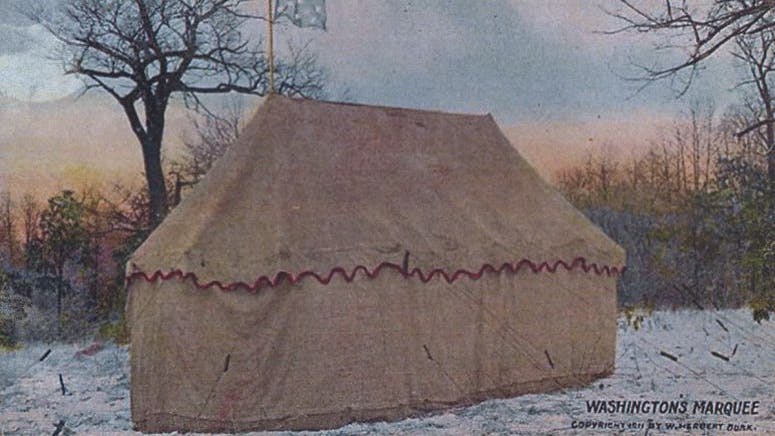
Historical Timeline
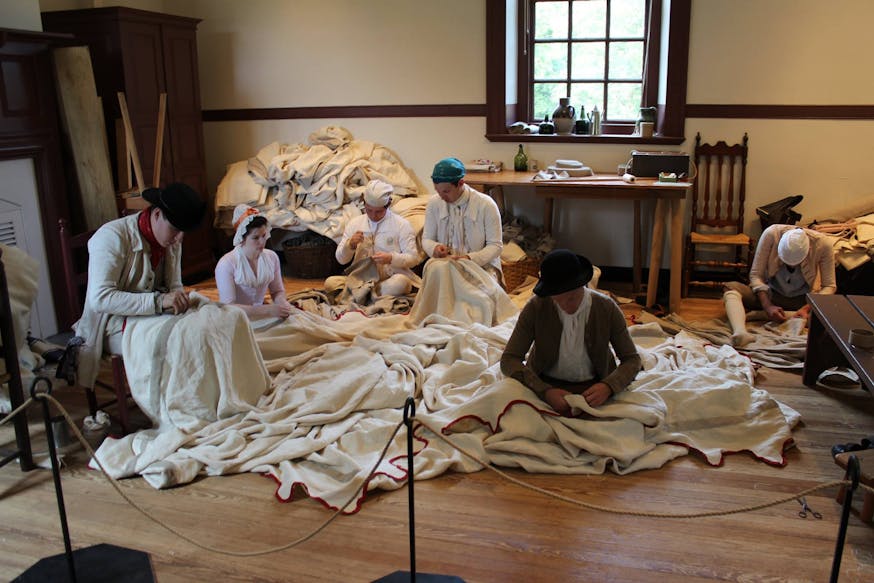
Real and Replica: Constructing The First Oval Office Project
